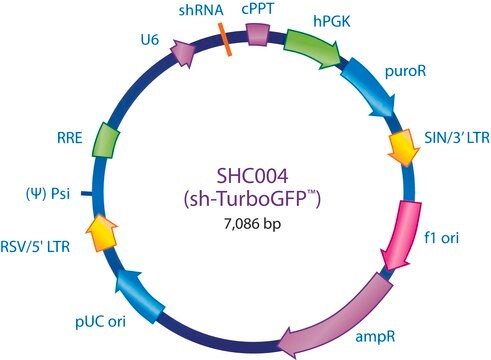추천 제품
Quality Level
100
200
제품 라인
MISSION®
농도
≥1x106 VP/ml (via p24 assay)
기술
capture ELISA: 106 TU/mL using p24
배송 상태
dry ice
저장 온도
−70°C
유사한 제품을 찾으십니까? 방문 제품 비교 안내
일반 설명
This shRNA non-mammalian control was designed using our Turbo GFP sequence and may cause some knockdown of tGFP. For maximum knockdown of tGFP, please refer to SHC004, SHC004V, SHC004H, SHC204, or SHC204V.
Small interfering RNAs (siRNAs) expressed from short hairpin RNAs (shRNAs) are a powerful way to mediate gene specific RNA interference (RNAi) in mammalian cells. The MISSION product line is based on a viral vector-based RNAi library against annotated mouse and human genes. shRNAs that generate siRNAs intracellularly are expressed from amphotropic lentivirus viral particles, allowing screening in a wide range of mammalian cell lines. In these cell lines, MISSION shRNA clones permit rapid, cost efficient loss-of-function and genetic interaction screens.
The lentiviral transduction particles are produced from an shRNA lentiviral non-target control plasmid. It is useful as a negative control in experiments with the MISSION shRNA target sets.
Unlike murine-based MMLV or MSCV retroviral systems, lentiviral-based particles permit efficient infection and integration of the specific shRNA construct into differentiated and non-dividing cells, such as neurons and dendritic cells,1 overcoming low transfection and integration difficulties when using these cell lines. Self-inactivating replication incompetent viral particles are produced in packaging cells (HEK293T) by co-transfection with compatible packaging plasmids.2-3
In addition, the lentiviral transduction particles are pseudotyped with an envelope G glycoprotein from vesicular stomatitis virus (VSV-G), allowing transduction of a wide variety of mammalian cells.4 The lentiviral transduction particles are titered via a p24 antigen ELISA assay and pg/ml of p24 are then converted to transducing units per ml using a conversion factor. The conversion can be viewed at: www.tronolab.com.
Small interfering RNAs (siRNAs) expressed from short hairpin RNAs (shRNAs) are a powerful way to mediate gene specific RNA interference (RNAi) in mammalian cells. The MISSION product line is based on a viral vector-based RNAi library against annotated mouse and human genes. shRNAs that generate siRNAs intracellularly are expressed from amphotropic lentivirus viral particles, allowing screening in a wide range of mammalian cell lines. In these cell lines, MISSION shRNA clones permit rapid, cost efficient loss-of-function and genetic interaction screens.
The lentiviral transduction particles are produced from an shRNA lentiviral non-target control plasmid. It is useful as a negative control in experiments with the MISSION shRNA target sets.
Unlike murine-based MMLV or MSCV retroviral systems, lentiviral-based particles permit efficient infection and integration of the specific shRNA construct into differentiated and non-dividing cells, such as neurons and dendritic cells,1 overcoming low transfection and integration difficulties when using these cell lines. Self-inactivating replication incompetent viral particles are produced in packaging cells (HEK293T) by co-transfection with compatible packaging plasmids.2-3
In addition, the lentiviral transduction particles are pseudotyped with an envelope G glycoprotein from vesicular stomatitis virus (VSV-G), allowing transduction of a wide variety of mammalian cells.4 The lentiviral transduction particles are titered via a p24 antigen ELISA assay and pg/ml of p24 are then converted to transducing units per ml using a conversion factor. The conversion can be viewed at: www.tronolab.com.
When conducting experiments using MISSION® shRNA clones, the proper controls should be a key element of your experimental design to allow for accurate interpretation of knockdown results. The MISSION Control Transduction Particles are a critical positive control to monitor transduction efficiency.
To see more application data, protocols, vector maps visit sigma.com/shrna.
To see more application data, protocols, vector maps visit sigma.com/shrna.
애플리케이션
MISSION® pLKO.1-puro Non-Mammalian shRNA Control Transduction Particles has been used as a negative control in ACSS2 (cytosolic acetyl-CoA synthetase) knock down study. It has also been used to study the effects of transduction.
To see more application data, protocols, vector maps visit sigma.com/shrna.
법적 정보
MISSION is a registered trademark of Merck KGaA, Darmstadt, Germany
추천
제품 번호
설명
가격
Storage Class Code
12 - Non Combustible Liquids
WGK
WGK 3
Flash Point (°F)
Not applicable
Flash Point (°C)
Not applicable
개인 보호 장비
Eyeshields, Gloves, multi-purpose combination respirator cartridge (US)
시험 성적서(COA)
제품의 로트/배치 번호를 입력하여 시험 성적서(COA)을 검색하십시오. 로트 및 배치 번호는 제품 라벨에 있는 ‘로트’ 또는 ‘배치’라는 용어 뒤에서 찾을 수 있습니다.
이미 열람한 고객
The Nrf1 CNC-bZIP protein promotes cell survival and nucleotide excision repair through maintaining glutathione homeostasis
Han W, et al.
The Journal of biological chemistry, jbc-M112 (2012)
Takeshi Fujii et al.
Journal of orthopaedic research : official publication of the Orthopaedic Research Society, 36(5), 1334-1345 (2017-10-29)
Although the number of patients with intervertebral disc (IVD) degeneration is increasing in aging societies, its etiology and pathogenesis remain elusive and there is currently no effective treatment to prevent this undesirable condition. The unfolded protein response (UPR) is a
P2X4 assembles with P2X7 and pannexin-1 in gingival epithelial cells and modulates ATP-induced reactive oxygen species production and inflammasome activation
Hung SC,et al.
PLoS ONE, 8(7), e70210-e70210 (2013)
Panu K Luukkonen et al.
Journal of hepatology, 67(1), 128-136 (2017-02-27)
Carriers of the transmembrane 6 superfamily member 2 E167K gene variant (TM6SF2 Liver biopsies were taken from subjects characterized with respect to the TM6SF2 genotype, serum and liver lipidome, gene expression and histology. In vitro, after TM6SF2 knockdown in HuH-7
David Gilot et al.
Nature cell biology, 19(11), 1348-1357 (2017-10-11)
Competition among RNAs to bind miRNA is proposed to influence biological systems. However, the role of this competition in disease onset is unclear. Here, we report that TYRP1 mRNA, in addition to encoding tyrosinase-related protein 1 (TYRP1), indirectly promotes cell
문서
Enhancing Lentiviral Transduction Efficiency
프로토콜
This detailed procedure allows you to transduce Mouse Embryonic Fibroblasts (MEF) using MISSION ExpressMag Super Magnetic Kit.
자사의 과학자팀은 생명 과학, 재료 과학, 화학 합성, 크로마토그래피, 분석 및 기타 많은 영역을 포함한 모든 과학 분야에 경험이 있습니다..
고객지원팀으로 연락바랍니다.






